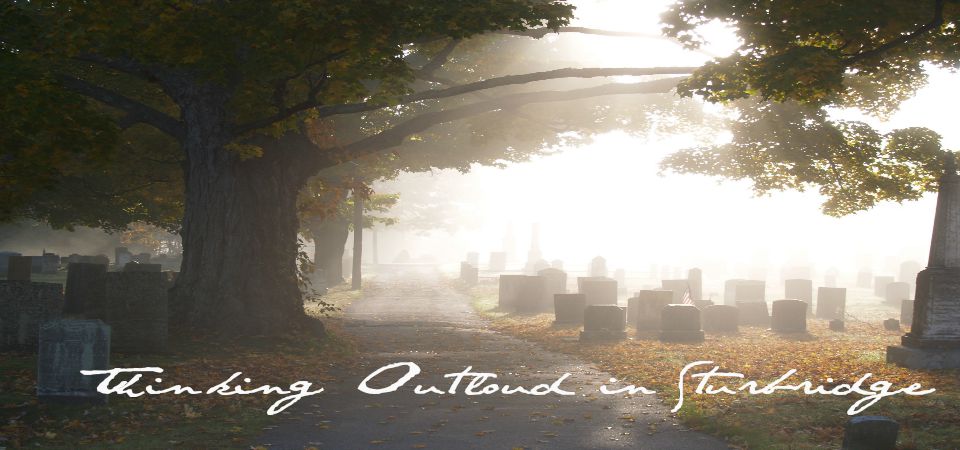Sixty miles west of Boston, Massachusetts there is the small New England town of Sturbridge. Located at the junction of I-90 (The Mass Pike), and I-84 it has become known as the "Crossroads of New England". The town was first settled over 300 years ago, and like other small New England towns it has grown just enough over the years to be in a difficult place today. How do we embrace the future without forgetting how we got to our present? How do we attract the right kind of growth, and maintain who we are? And, what about our culture out here in Central Massachusetts?
These pages will cause one to think about how to protect what we have, our future direction, and how to move on in the very best way.
Those thoughts, and other ramblings, will hopefully inspire more thought, conversation, action, and occasionally a smile...
...seems to be working so far
Monday, March 17, 2008
A Great Comment: A Daily Readers View
"Yeah, it is awesome, and freakin' amazing. It's also about time that there is discussion taking place, and I agree, more discussion before June would be good. Thank you, for your post about the EDC and Selectmen touting ecotourism in Sturbridge.
There have been ecotourism studies already completed in central Mass, that is no secret. One has been touted by the Chamber of Commerce and Old Sturbridge Village. Selectmen have also mentioned one at their meetings, a study completed in north central Massachusetts in the Quabbin area. Hmmm...does anyone else think it's possible to do "ecotourism" on a regional basis with our Quabbin Reservoir neighbors to the north?
What kind of results do these studies recommend?
1) protect the economic base in Sturbridge - hospitality & retail, because we're becoming more dependent on it. 2)protect the fabric of the community. 3) extend visits to multiple activities and overnight stays by leveraging more events; consider camping and outdoor activity as the primary immediate opportunity; improve merchandising of the tourist product through better packaging. 4) align visitor expectations and experience by enhancing the look and feel, and also by providing enhancements to drive repeat visits. 5) expand group/business meeting segments, by reconnecting w/group business activity.
Specific actions suggested: 1) design standards for part or all of the community. 2) implementing zoning and land use regulations to protect open space and manage sprawl. 3) "view shed" protections 4) redesign the "gateway" - the list goes on and on.
As we know, there are naysayers in Sturbridge who think "Sturbridge is dying". Some of them are people who are new to Sturbridge, who perhaps have never owned a business, and who only see what has happened on the surface, not the real reasons why some businesses have left Sturbridge. It's so much easier to blame "the town" than be honest about why businesses fail.
There are those who just can't comprehend what the professionals are telling them: ecotourism CAN be, and SHOULD be, what Sturbridge does.
Sturbridge was built around Old Sturbridge Village; the businesses here survive on the tourist traffic generated by it, as well as the Brimfield Auctions, events on the Sturbridge Common, etc.
If a community has the foresight to plan for its long term fiscal well-being through the design and implementation of a well balanced land use base, it will, in the long run, develop a stable tax base that is equipped to weather the fiscal fluctuations. Until now it seems, Sturbridge has lacked that foresight. The current Selectboard has inherited this problem, passed forward to them from previous Selectboards. Most certainly, it will take EVERYONE to make it work, and that includes the naysayers.
Given Sturbridge's current situation, especially with regard to the cost of increasing sewer capacity plus building or renovating a new elementary school, can someone please explain how building another strip mall on Route 15 will help the tax base, or the senior citizens?
Wouldn't it be more desirable to direct development to areas where the existing infrastructure is capable of absorbing more growth, to locations where improvements could be made in a more cost efficient manner? Development could be coordinated with a long range capital improvement plan or budget, and capital outlays may be timed in conjunction with predicted needs in areas where growth is expected.
How about examining existing zoning regulations to see how they impact upon municipal operating and capital budgets? For example, development patterns that minimize the need for extensive roadways, water and sewer lines, and other improvements make sense from a fiscal perspective.
Yeah, 'sehtsumgoals. Begindaplan. Begindaplan.' "
Written by A Daily Reader

I love it! Thank you for sharing.
ReplyDeleteIt is nice to see a move in a positive direction - now if everyone can get on board....oh what a Sturbridge we could be!